Study on Microstructure and Properties of NM500/Q345 Clad Plates at Different Austenitization Temperatures
Abstract
1. Introduction
2. Experimental Materials and Procedures
3. Results and Discussion
3.1. Microstructural Analysis
3.2. Mechanical Property Analysis
3.3. Friction and Wear Analysis of Clad NM500
4. Conclusions
- The microstructure of the NM500/Q345 clad plate before austenitization was mainly pearlite and ferrite, and both were transformed into lath martensite after austenitization. The structures obtained at each austenitization temperature were all martensite structures, and the martensite was in the shape of lath. As the austenitization temperature increased, the size of the martensitic lath bundle also became coarse. After quenching at 900 °C + tempering at 200 °C, in the lath-like martensite structure of NM500, there were many substructures between the laths, and a certain number of needles were of precipitated shape or rod-shaped ε precipitates.
- When quenched at 860 °C + tempered at 200 °C, the martensite arrangement was uneven, and the microstructure could not be completely transformed into austenite. When quenched at 900 °C + tempered at 200 °C, the structure had relatively clear prior austenite grain boundaries, and the martensite arrangement was relatively neat. When quenched at 940 °C + tempered at 200 °C, the austenitized grains grew, and large martensitic laths formed during austenitization. Therefore, the trend of the tensile strength and elongation of the composite plate first increased and then decreased with the increase in the quenching temperature.
- When quenched at 900 °C + tempered at 200 °C, its elongation and tensile strength were the largest, which were 22.68% and 1432.28 Mpa, respectively. As the austenitization temperature increased to 940 °C, the tensile strength and elongation decreased slightly compared with those of the samples at 900 °C. Due to the martensite structure that formed after quenching, the hardness of the wear-resistant layer of the composite plate first increased and then decreased with the increase in the quenching temperature. The Rockwell hardness of the original sample was 30.3 HRC. When the quenching temperature was 860 °C, the hardness increased to 44.6 HRC. When the quenched temperature was 900 °C, the hardness reached the maximum, which was 47.2 HRC, When the quenching temperature was 940 °C, the hardness decreased to 45.8 HRC.
- The original sample before austenitization had a soft material, and it was easy to produce wear debris on the surface, which reduced the surface roughness and minimized the friction coefficient. After austenitization + tempering, the hardness of the wear-resistant steel increased, the wear resistance also increased, and the friction coefficient increased with it. After quenching at 860 °C and tempering at 200 °C, the friction coefficient was the largest. When the austenitization temperatures were 900 °C and 940 °C, the friction coefficient was not much different. The wear was the worst when the material was not quenched. After austenitization at 900 °C + tempering at 200 °C, the wear of NM500 was the lightest; the maximum depth of the wear scar was 14 μm; the width was the narrowest, 0.73 mm; and the wear volume was the smallest, 0.0305 mm3.
Author Contributions
Funding
Institutional Review Board Statement
Informed Consent Statement
Data Availability Statement
Acknowledgments
Conflicts of Interest
References
- Zhao, D. Study on Tribological Performance of Three Commonly Used Wear-Resistant Steels. Master’s Thesis, China University of Mining and Technology, Xuzhou, China, 2017. [Google Scholar]
- Liu, P.T.; Ma, L.F.; Zhi, C.C.; Ma, Z.; Zhou, C.; Zhao, G.; Fan, Q.; Jia, W. Effect of Annealing on Heavy-Load Wear Performance of Wear Resisting Steel-Carbon Steel-Cladded Plate. Tribol. Trans. 2020, 64, 101–110. [Google Scholar] [CrossRef]
- Ye, J.; Zhang, H.; Liu, X.; Liu, K. Low Wear Steel Counterface Texture Design: A Case Study Using Micro-pits Texture and Alumina–PTFE Nanocomposite. Tribol. Lett. 2017, 65, 165. [Google Scholar] [CrossRef]
- Liang, L.; Yan, L.; Li, G.; Yi, C.; Xiangtao, D.; Zhaodong, W. Effect of Heat Treatment on Microstructure and Mechanical Properties of Low-Alloy Wear-Resistant Steel NM450. Mater. Res. Express 2021, 8, 045606. [Google Scholar] [CrossRef]
- Hussein, A.; Ahmed, M.R.; Abid, H.; Alzaid, M.; Farhat, L.B.; Badruddin, I.A. Effects of gating design on structural and mechanical properties of high manganese steel by optimizing casting process parameters. J. Mech. Sci. Technol. 2022, 36, 3931–3937. [Google Scholar]
- Pei, W.; Zhang, Y.; Yang, S.; Li, X.; Zhao, A. Study of work-hardening behavior of high manganese steel during compression. Mater. Res. Express 2022, 9, 066503. [Google Scholar] [CrossRef]
- Wu, X. Study on Mechanical Properties and Wear Resistance of Microalloyed Low Alloy Wear Resistant Steel. Master’s Thesis, Zhengzhou University, Zhengzhou, China, 2020. [Google Scholar]
- Li, H.; Zhao, G.; Ma, L.; Li, J.; Zhi, C. Microstructure analysis of hot-rolled NM500/Q345/NM500 composite interface. Mater. Res. Express 2019, 6, 016548. [Google Scholar] [CrossRef]
- Zhao, G.; Zhang, J.; Song, Y.; Li, J.; Li, H.Y.; Shuai, M.R. Study on friction and wear properties of wear-resistant layer of NM500/Q345 composite plate at different quenching temperatures. Precis. Form. Eng. 2021, 13, 35–41. [Google Scholar]
- Bao, S.; Yang, G.; Xu, Y.; Han, N.; Zhu, X. Austenite grain growth behavior of medium manganese martensitic NM500 steel. Steel 2022, 57, 152–159. [Google Scholar]
- Cheng, M.H. Research on NM500/Q345/NM500 Three Layer Rolling Composite and Heat Treatment Process. Master’s Thesis, Taiyuan University of Science and Technology, Taiyuan, China, 2018. [Google Scholar]
- Cheng, M.; Huang, Q.; Zhao, G.; Ma, L.F. Effect of reduction ratio on microstructure and tensile fracture of vacuum hot rolled NM360/Q345R clad plate. Acta Mater. Metall. 2017, 16, 286–292. [Google Scholar]
- Li, J.; Liu, C.R.; Song, Y.H.; Zhao, G.; Ma, L.; Huang, Q. Influence of Hot Rolling + Heat Treatment on Microstructure and Mechanical Properties of NM500/Q345/NM500 Composite Plate. J. Mater. Sci. 2021, 56, 6016–6030. [Google Scholar] [CrossRef]
- Qiu, J.; Cheng, X.R.; Lan, K.; Lan, D.; Wang, Y.; Huang, D.J. Effect of Rolling and Heat-Treatment on Structure and Properties of Wear-Resistant Steel NM450D-Carbon Steel Q235B Clad Plate. Spec. Steel 2017, 38, 56–59. [Google Scholar]
- Lan, K.; Cheng, X.R.; Qiu, J.; Lei, D.; Peng, Y. Influence of Reduction Ratio on Interfacial Bonding Properties of Wear-Resistant Steel and Carbon Steel Composite Plate. Hot Work. Technol. 2017, 46, 121–124. [Google Scholar]
- Li, J.; He, Q.Z.; Li, H.; Zhao, G.H.; Cheng, M.H. Research on mechanical properties and interface microstructure of hot-rolled NM360/Q345R composite plate. Hot Work. Technol. 2018, 47, 118–121. [Google Scholar]
- Zhu, C.; Cerezo, A.; Smith, G.D.W. Carbide characterization in low-temperature tempered steels. Ultramicroscopy 2009, 109, 545–552. [Google Scholar] [CrossRef] [PubMed]
- Ceschini, L.; Marconi, A.; Martini, C.; Morri, A.; Di Schino, A. Tensile and impact behaviour of a microalloyed medium carbon steel: Effect of the cooling condition and corresponding microstructure. Mater. Des. 2013, 45, 171–178. [Google Scholar] [CrossRef]
- Jia, T.; Li, M.; Pei, X.; Wang, Z. On the Spheroidizing Annealing Behavior in Cr/Nb Microalloyed Medium Carbon Steels. Steel Res. Int. 2018, 90, 1800353. [Google Scholar] [CrossRef]
- Dewangan, S. Effect of heat treatment into tensile strength, hardness and microstructural attributes of TIG welded Ti-6AL-4V titanium alloy. Aust. J. Mech. Eng. 2022, 2059906. [Google Scholar] [CrossRef]
- Babaei, H.; Shafyei, A.; Amini, K. The Effect of Heat Treatment on Mechanical Properties and Microstructure of the AISI 422 Martensitic Stainless Steel. Mechanika 2017, 22, 13599. [Google Scholar] [CrossRef]
- Dwangan, S.; Nemade, V.V.; Nemade, K.H.; Bohra, P.M.; Kartha, S.R.; Chowrasia, M.K. A discussion on mechanical behaviour of Heat-Treated low carbon steel. Mater. Proc. 2022, 63, 362–367. [Google Scholar] [CrossRef]
- Mo, D.Y.; Gong, M.F.; Wu, H.B.; Song, R. Surface Modification of 5Cr5MoWSi Steel and Tribological Properties. Mach. Des. Manuf. 2020, 12, 95–99. [Google Scholar]
- Li, Y.L.; Bao, H.S.; Li, Q. Effect of Hardness on Rolling Wear Properties of 95Cr18 Steel. Met. Funct. Mater. 2020, 27, 38–45. [Google Scholar]
- Jiang, M.M.; Cao, P.; Zhao, Y.H.; Geng, H.R.; Li, J.; Gong, Z.Y. Effect of Different Load and Rotating Speed on Wear Properties of Vacuum-Quenched Cr12MoV Steel. Hot Work. Technol. 2020, 1, 143–146+150. [Google Scholar]
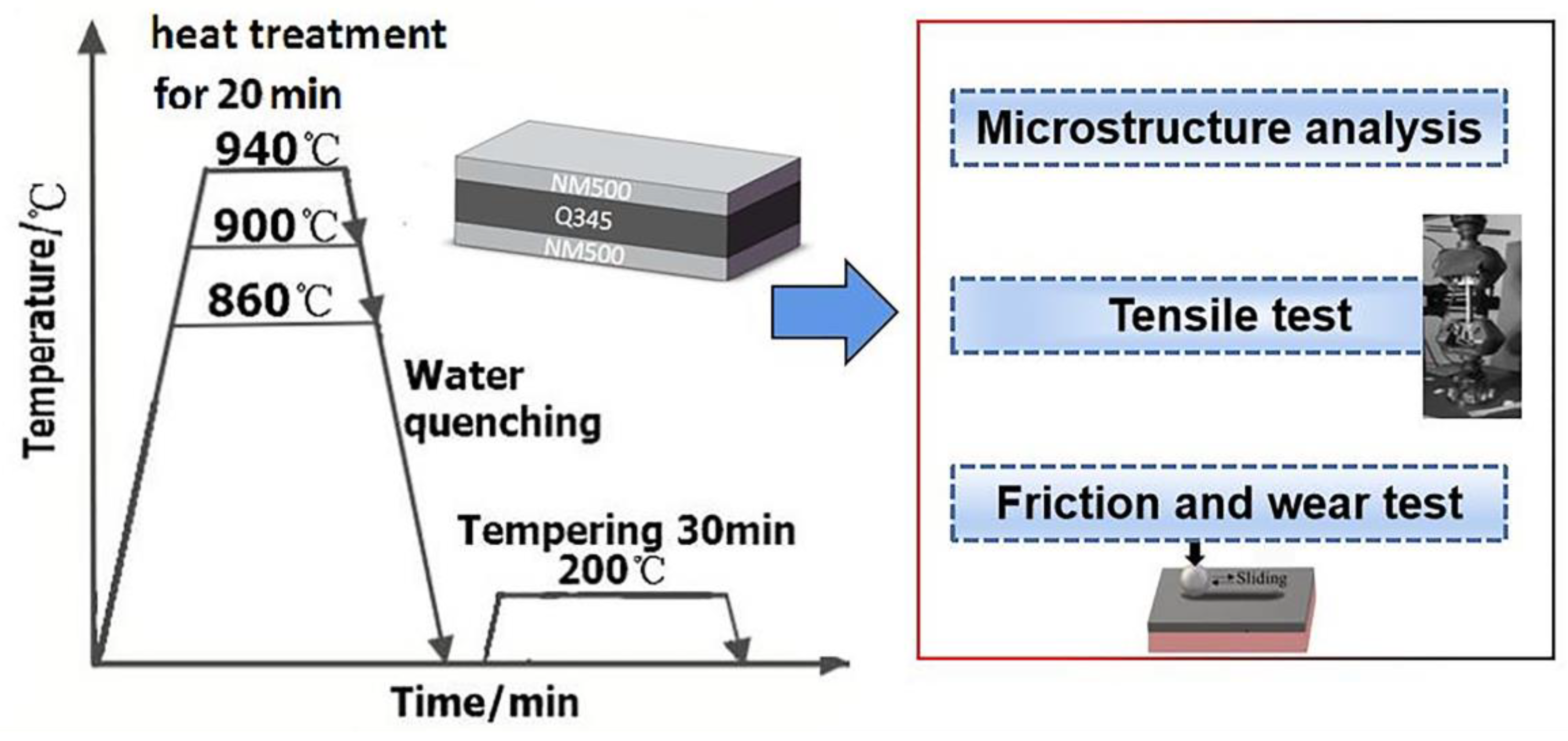
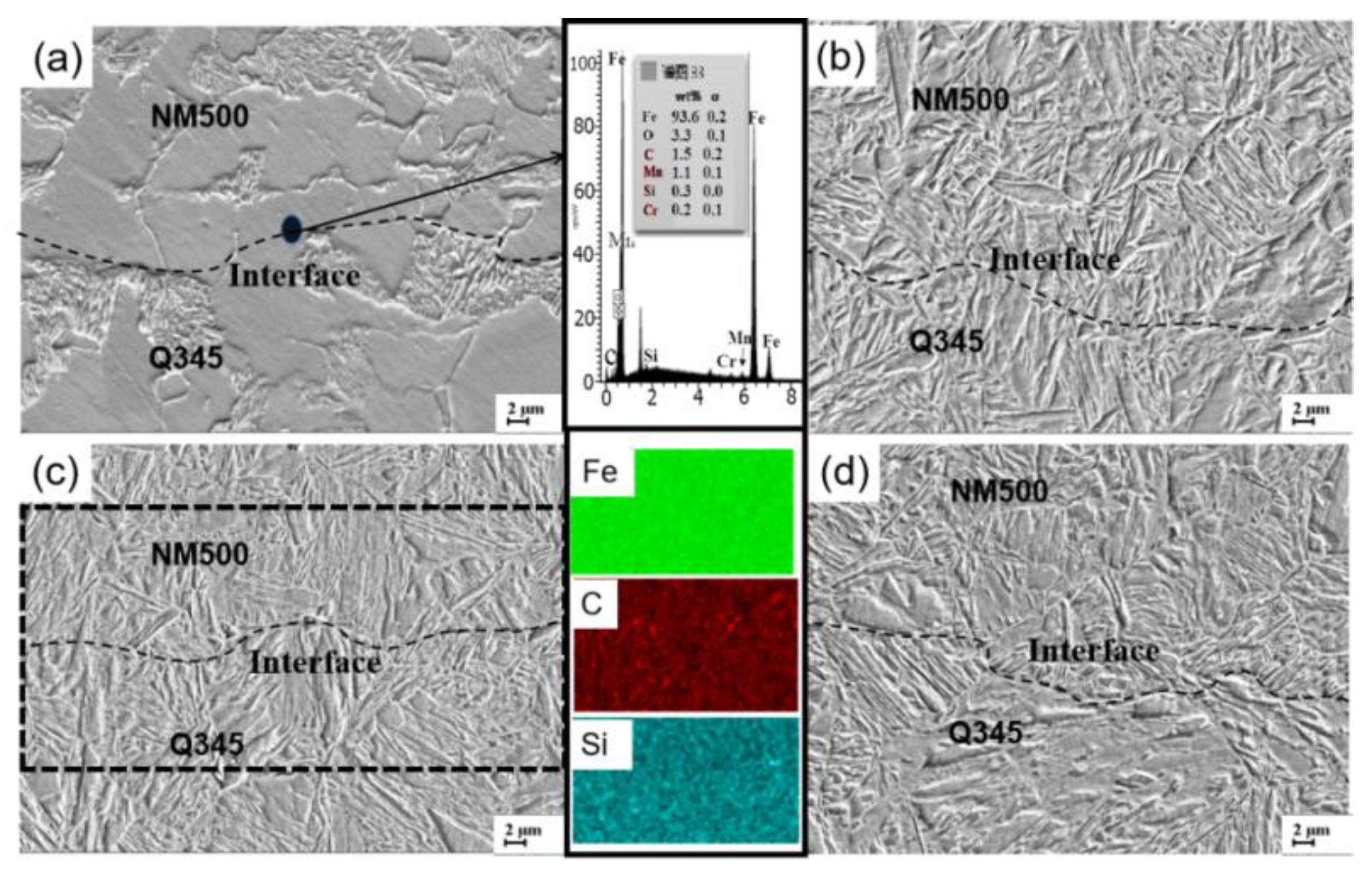

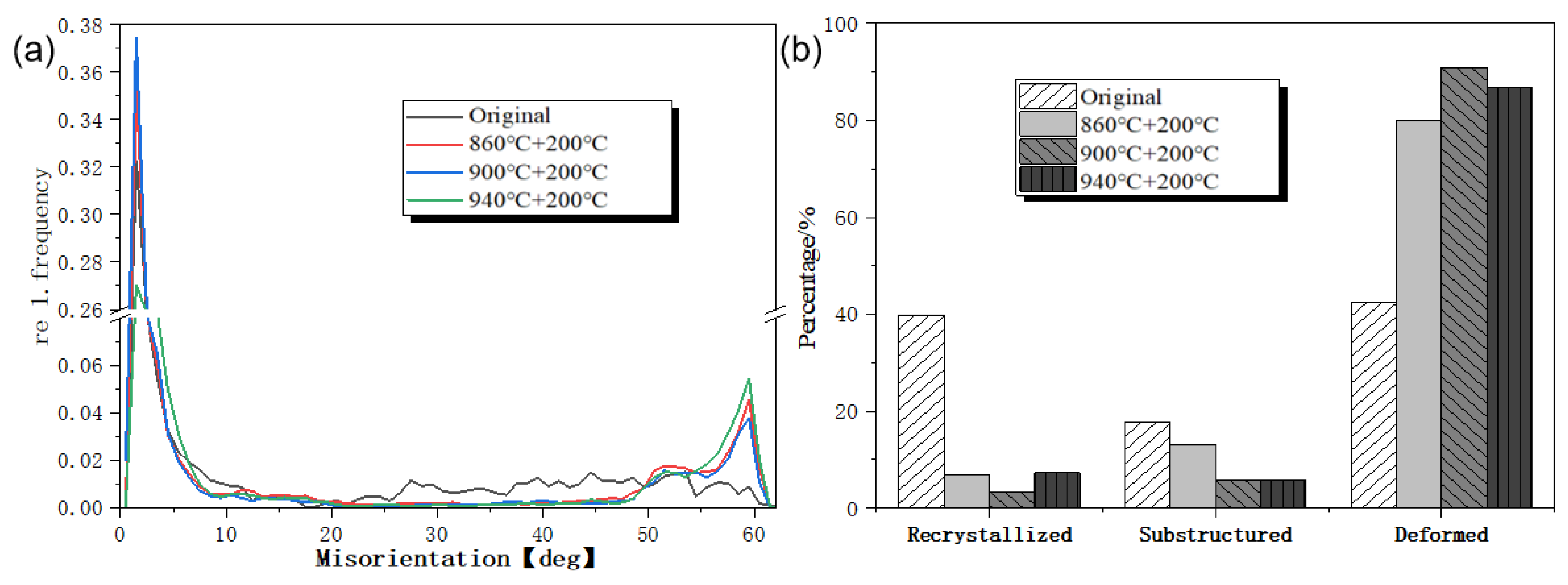
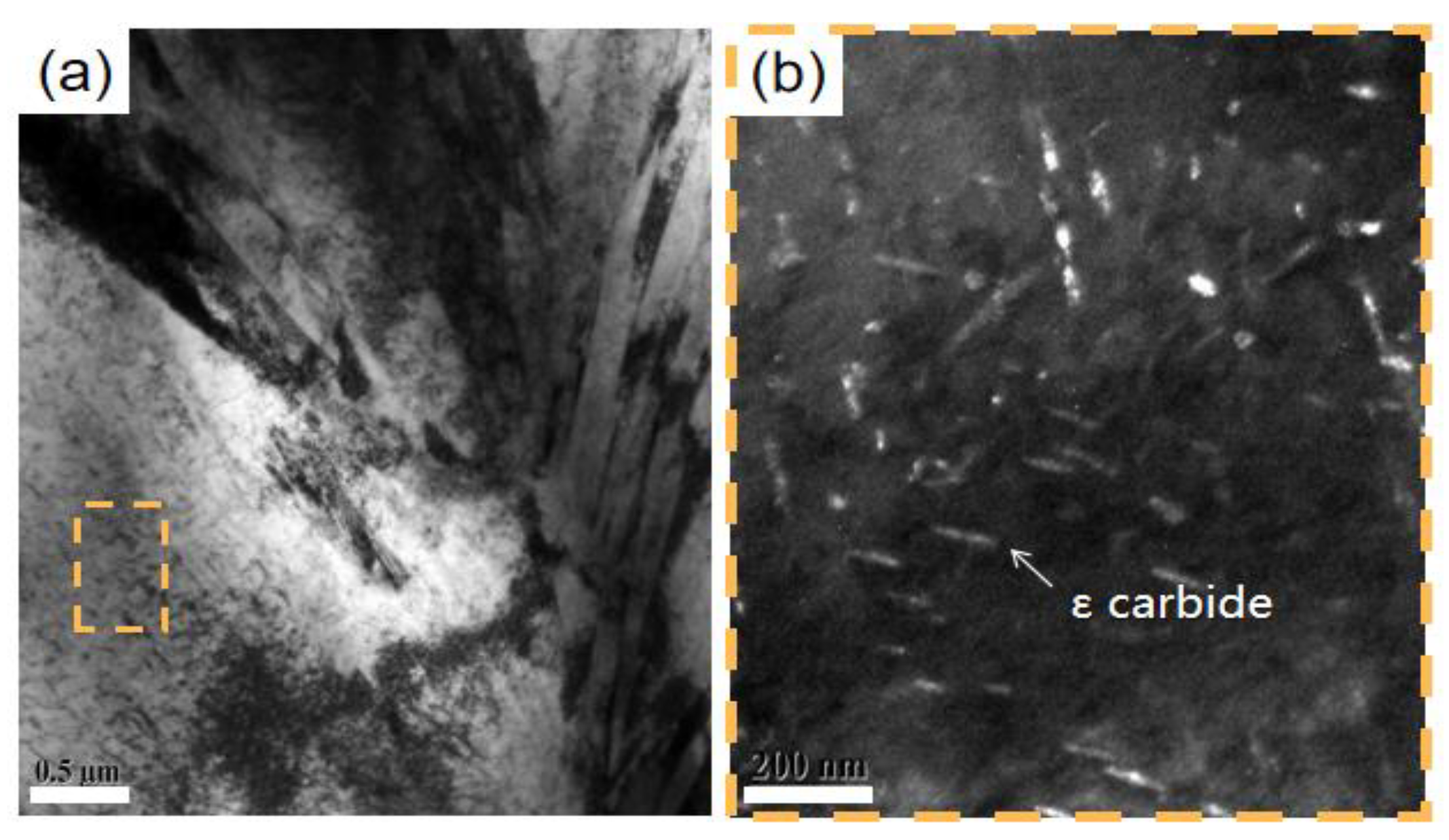
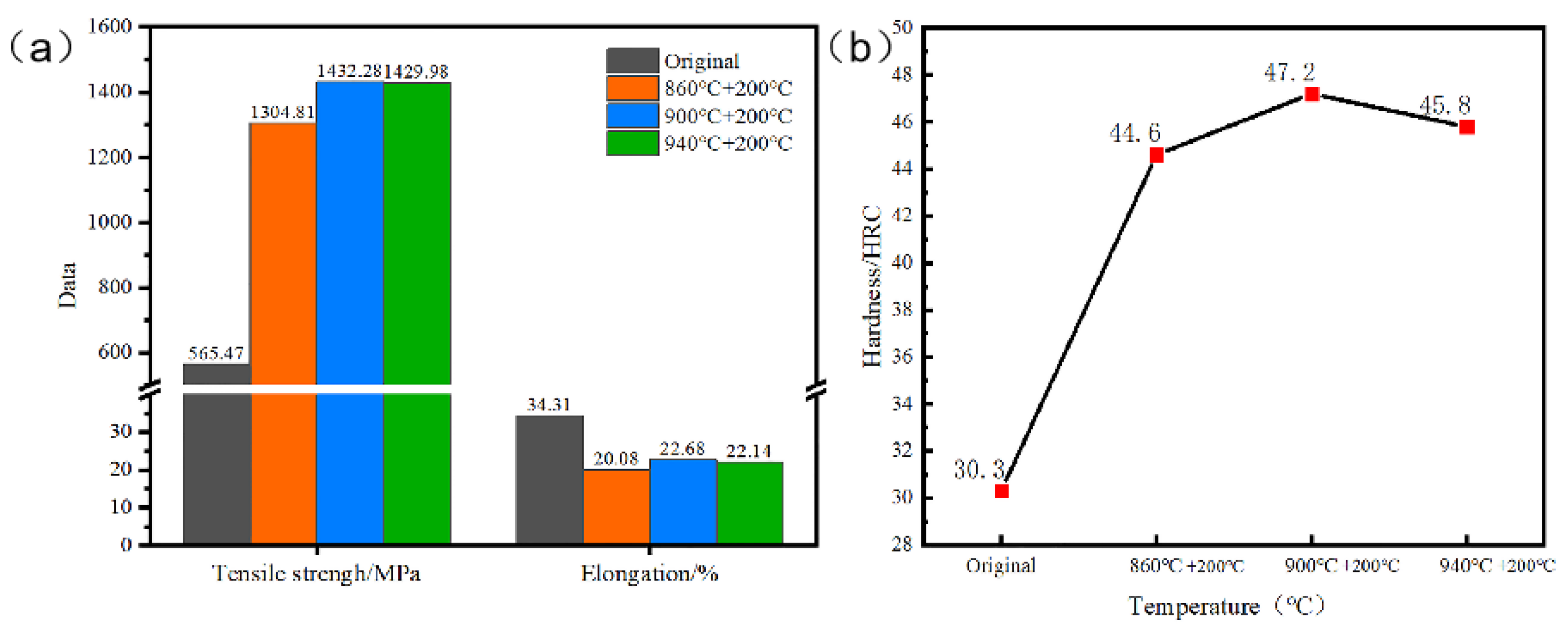



| C | Si | Mn | P | S | Cr | Ni | Mo | Ti | V | Fe |
|---|---|---|---|---|---|---|---|---|---|---|
| 0.13 | 0.44 | 1.52 | 0.013 | 0.004 | Bal |
| C | Si | Mn | P | S | Cr | Ni | Mo | Ti | B | Al |
|---|---|---|---|---|---|---|---|---|---|---|
| 0.38 | 0.40 | 1.70 | 0.020 | 0.010 | 1.20 | 1.00 | 0.65 | 0.050 | 0.00045 | 0.010 |
Publisher’s Note: MDPI stays neutral with regard to jurisdictional claims in published maps and institutional affiliations. |
© 2022 by the authors. Licensee MDPI, Basel, Switzerland. This article is an open access article distributed under the terms and conditions of the Creative Commons Attribution (CC BY) license (https://creativecommons.org/licenses/by/4.0/).
Share and Cite
Zhao, G.; Zhang, R.; Li, J.; Liu, C.; Li, H.; Li, Y. Study on Microstructure and Properties of NM500/Q345 Clad Plates at Different Austenitization Temperatures. Crystals 2022, 12, 1395. https://doi.org/10.3390/cryst12101395
Zhao G, Zhang R, Li J, Liu C, Li H, Li Y. Study on Microstructure and Properties of NM500/Q345 Clad Plates at Different Austenitization Temperatures. Crystals. 2022; 12(10):1395. https://doi.org/10.3390/cryst12101395
Chicago/Turabian StyleZhao, Guanghui, Ruifeng Zhang, Juan Li, Cuirong Liu, Huaying Li, and Yugui Li. 2022. "Study on Microstructure and Properties of NM500/Q345 Clad Plates at Different Austenitization Temperatures" Crystals 12, no. 10: 1395. https://doi.org/10.3390/cryst12101395
APA StyleZhao, G., Zhang, R., Li, J., Liu, C., Li, H., & Li, Y. (2022). Study on Microstructure and Properties of NM500/Q345 Clad Plates at Different Austenitization Temperatures. Crystals, 12(10), 1395. https://doi.org/10.3390/cryst12101395





